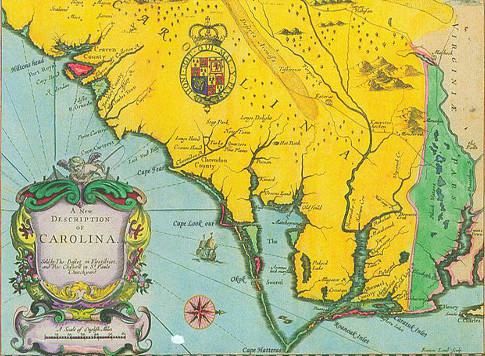Aside from the failed attempt at a colony in Roanoke, the French and Spanish had also failed in claiming the coast where the Carolinas would be established.
The North Carolina Colony and the South Carolina Colony were established at the same time. In 1663, King Charles I of England annulled a previous charter and gave a new charter as a gift to eight English noblemen who had supported his rise to the throne. The charter included all of the land between the border of the Virginia colony and the southern border of modern-day Georgia. The border was changed several times over the years, covering as far down as modern-day Daytona Beach, FL. The land was called Carolina (as the Latin form of the name Charles is Carolus).

Map of Carolina, before it was split.
Drawn by John Speed (1542 – 1629) | public domain image
These eight men, called the Lords Proprietors, had control of the land, almost completely independent of the crown. Lord Shaftesbury drew up a plan for the government of the colony. John Berkely and George Carteret were interested in the Province of New Jersey, and William Berkeley in Virginia.
There was already a small settlement in the northeastern corner of the area. Emigrants from the Virginia Colony along with others from New England lived in the Albemarle settlement, called “Rouge’s Harbor” for offering assistance and refuge during Bacon’s Rebellion.
The Lords Proprietors began establishing settlements including Cape Fear, Clarendon, and Charles-Town (eventually Charleston) which became the government seat of the entire province. The sections were so remote from each other that they operated mostly independently of each other until one governor was appointed over the entire province. They came under one government, but the governor lived in Charleston and appointed a deputy-governor for the north. They became increasingly known as North and South Carolina.
Unlike the other colonies, these flourished quickly. Slavery was permitted from the very beginning, and tobacco farms coupled with the growing trade in the West Indies made for a fast-growing economy. The Tuscarora and Yamasee Wars with the Native Americans as well as the distance of the ruling Proprietors eventually led to the decision to have separate governments for the North and South Carolinas.
In 1729, seven of the Lords Proprietors sold their interests in the colonies back to the Crown and they became royal colonies. The last one was seized by the North Carolina government during the Revolutionary War.


